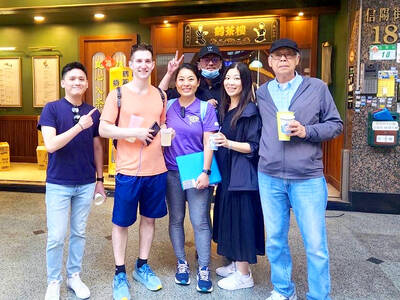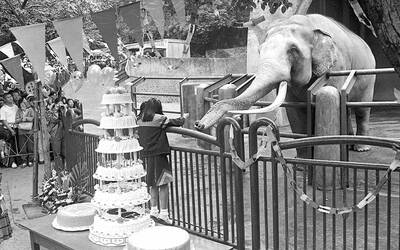The elephant raised its head above the vegetation and fixed us with a yellow eye. We were in the thick of the African jungle; exposed, vulnerable and with few options for escape. We froze, and I registered two things: the gentle sea breeze on the back of my neck, which must have carried our scent to the animal, and the fact that she had two calves with her. Things could not be any worse.
After a few moments I risked slowly turning my head to identify an exit route in case she charged. As I did so, a gust came in from the ocean and scythed through the bush, rattling the dried leaves of the palm trees above. The elephant lifted her trunk towards us in a powerful arc and sniffed the air, and then her eyes widened in outrage as she identified our scent. Her great ears stood out from her head as she flung up her trunk and uttered a wild and discordant cry of anger.
It was a sound unlike any that I have ever experienced — a far cry from the rather gentle trumpeting that I had often heard described. And then she began crashing through the vegetation towards us, running straight over trees and snapping branches like matchsticks. I glanced towards our guide, who had lived all his life in the jungle, and saw that he had turned to run. I followed suit, ducking and diving through a blur of vegetation until at last we popped out from the shade of the jungle onto the long white beach.
We stood panting beside a large washed-up log, waiting until the rest of the team emerged and then gathering in silence like survivors from a bombed-out house. I could see we were all equally shaken, and we barely managed to utter a few words of relief. I kept looking towards the dense wall of jungle that towered over the beach, waiting for the elephant to crash through after us, but nothing came.
Luckily it had been a bluff charge, but if we had stayed put it would have become real. We sat down on the log, and one of the crew pointed out three more elephants standing 800m or so down the beach, part shrouded in mist from the breaking waves. Later we would see buffalo roaming the beach too, and there were rumors that hippos had been seen playing about in the surf from time to time. We had all seen these animals before, but never in such a dreamlike setting. It felt elemental, enchanted, and I would not have been surprised if Adam and Eve had shot past on surfboards, such was the wonder of the place.
I was visiting Gabon to work on the BBC series Living with the Monkeys, and it made quite a contrast with my location one week earlier: home in Scotland, surrounded by a grumbling family all suffering from the obligatory winter colds and recovering from a prolonged bout of overindulgence, Hebrides-style, over the festive season (Christmas and New Year).
Gabon is an incurably exotic country. Straddling the equator, it is the second largest jungle zone on earth and was once connected to the Amazon when the continents were joined. I had been asked to take part in the series at the end of last year, and the fact that I knew absolutely nothing about the country (as well as being in the depths of a interminably dark, grim and
rainy Scottish winter) only added to
the appeal.
THE MORE THINGS CHANGE ...
In preparation for the trip I tried to find a guidebook about the country, and found none in print in English and only a scant few in French. The beautiful fact is that we still know very little about Gabon.
What I did know, however, was that the west coast of Africa has played an important role in our history, and was a key destination for Victorian Britons seeking adventure or fortune. This jungle inspired the Tarzan legend, and as part of the water catchment for the Congo River, is close to where Conrad worked as a steamboat captain for the despotic Leopold II, inspiring him to write Heart of Darkness.
Slaves, timber and ivory had all been loaded onto ships along this coast, and in the other direction came traders and their equipment. I came across lonely burial grounds along the coastline where gravestones designed to stand in the steady ground of northern churchyards now lean at an angle in the yielding sand. Ships bound from Europe for Africa used gravestones as their ballast, as the expected lifespan of the colonists was so short.
On arrival in Gabon I discovered that not much has changed. Timber is still exported, elephants are still killed for their ivory and local people’s lives are still dominated by the needs and desires of inscrutable people in distant lands. Gabon is a relatively prosperous and peaceful country, however, despite being surrounded by countries that have been held in the demonic grip of atrocity and carnage with people and animals trapped within worlds of near-medieval cruelty.
The late president of Gabon, Omar Bongo Ondimba [see note at end], designated 10 percent of the country as national parkland. The result of this is 13 national parks with an overall landmass of more than 25,899km², and protected habitat for numerous unique and fascinating animal species.
MONKEY MISSION
Our destination could scarcely have felt more remote, and there were no short cuts to reach it. We flew from London to Paris then from Paris to Libreville, capital of Gabon. After a night in Libreville a 90-minute internal flight took us to the scruffy town of Gamba, close to the coast. From there we threaded our way through the lagoon in an overcrowded launch for four hours until we finally reached the village of Sette Cama, with a population of 200, where we picked up a small motorboat to take us 20 minutes further to our jungle camp.
Our mission on this expedition was to study a species of monkey named the red-capped mangabey about which very little is known. Along with my colleagues, primatologist Julie Anderson, who would be the brains of the study in liaison with local forest rangers and researchers, and Gavin Thurston, who has a distinguished record as a wildlife cameraman, I would be living like a monkey in the safest place in the jungle: the treetops. Specially designed wooden platforms would hang from the trees, placed high enough to be out of reach of the forest elephants.
The platforms would give us an ideal vantage point to view the animals while making minimal impact on their lives.
Our tree house was located on the edge of the Ndongo Lagoon which has more than 350 islands. We were a few kilometers from Sette Cama, which rather worryingly translates as “seven graves” in reference to the lost graves of seven Portuguese sailors believed to have died there. My role was to make sure that we could live happily and well in such a remote spot, and even though I had no experience of living in the jungle I hoped that the principles of wilderness living would remain largely the same.
My job was made far easier by the fact that Thurston and Anderson have good experience of living rough, and nobody was expecting things to be easy; however a few fundamentals are important for morale. First of these is a safe and effective outhouse hole. The theory was one thing but the practice was hellish, as I had barely acclimatized to the immense heat before I started digging, and felt as though I was in a Japanese endurance game show.
Next I set up rainwater collection tarpaulins, which would soon supply all our drinking water for the duration of our time in the tree. For washing, the answer was a Heath Robinson-style device that would allow us to wash in a corner of the tree house rather than going down to the lagoon. We all fell in love with the little tin bucket that flew backwards and forwards to the lagoon along its own flying squirrel, and soon she had a name: Hygienica.
Keeping cool and clean would soon become very important as Thurston and Anderson worked hard to get close to the monkeys, and I ranged further afield in search of food and local bushcraft and forest knowledge. It was also safer to wash well away from the water’s edge — nobody wanted to get too intimate with the 5m-long Nile crocodiles that inhabited the lagoon.
ROUGHING IT
Gradually we grew accustomed to life in the tree house, and as we are all devotees of the wild we adapted easily, even though Mother Nature extracted her little tax from time to time. As we had no insect screens we were awash with insect life, and every kind of cockroach and ant visited as well as myriad other creepy crawlies that looked as though they might have been designed by the studios of George Lucas. We came across the odd scorpion and an immense creature called scolopendra gigantean, which resembles a giant earwig and is one of the largest insects in the world. Reaching up to 35cm in length, it feeds on large prey such as bats, small birds and frogs, and has venom that can do serious damage to humans.
Once, I discovered one of these monsters sidling its way up the side of the tree house heading for Thurston’s living area. To Thurston and Anderson’s eternal credit they both stopped my boot just centimeters from doing what felt like common sense and kindly flicked the creature off the platform into the darkness below. We studiously checked our boots every morning.
I spent a lot of time on the lagoon, fishing and learning the ways of local people, many of whom have become firm friends. The lagoon is as large as the Netherlands and stippled with islands that look as though they might sink beneath the weight of their lush vegetation. Many are inhabited, and I was privileged to be able to visit one that is solely inhabited by two women, their mother and their seven children. These women had had quite enough of their ridiculous husbands, who huffed around like aggressive groupers, and had instead turned their little island into a paradise of efficiency and thrift. I sat with the grandmother and she let me share her pipe of extremely strong tobacco that they grew themselves.
They grew wonderful vegetables and were allowed to hunt sustainably for the pot, harvesting the occasional crocodile or buffalo from time to time. The village was surrounded by mango trees, bananas and other more exotic fruit and there was a strong, clear spring that gave them their water.
It was in this village that I witnessed a scene that must be as old as time itself; the grandmother scooping up one of her grandchildren and breast-feeding while she continued work mending a rattan roofing section. Sadly, the lagoon faces many threats. For centuries it has fed the little communities that live carefully and minimally on its fringes, but its mouth is silting up, making fish stocks scarce. Added to this, ruthless illegal fishing is allegedly taking place by foreign fishing boats, threatening the precarious existence of the local people still further.
When our sojourn in the jungle was finally at an end, we returned to our European homes on ever-more sophisticated transport, from small boat to fast launch, four-wheel drive then passenger jet. The tree house remains in situ, left for the local people to run for visiting scientists or hardy tourists who want to explore the jungle and waterways that surround their little village. As we left, we hoped that the film might help tell the story of some animals whose destruction has been hidden beneath the forest canopy.

A vaccine to fight dementia? It turns out there may already be one — shots that prevent painful shingles also appear to protect aging brains. A new study found shingles vaccination cut older adults’ risk of developing dementia over the next seven years by 20 percent. The research, published Wednesday in the journal Nature, is part of growing understanding about how many factors influence brain health as we age — and what we can do about it. “It’s a very robust finding,” said lead researcher Pascal Geldsetzer of Stanford University. And “women seem to benefit more,” important as they’re at higher risk of

Eric Finkelstein is a world record junkie. The American’s Guinness World Records include the largest flag mosaic made from table tennis balls, the longest table tennis serve and eating at the most Michelin-starred restaurants in 24 hours in New York. Many would probably share the opinion of Finkelstein’s sister when talking about his records: “You’re a lunatic.” But that’s not stopping him from his next big feat, and this time he is teaming up with his wife, Taiwanese native Jackie Cheng (鄭佳祺): visit and purchase a

April 7 to April 13 After spending over two years with the Republic of China (ROC) Army, A-Mei (阿美) boarded a ship in April 1947 bound for Taiwan. But instead of walking on board with his comrades, his roughly 5-tonne body was lifted using a cargo net. He wasn’t the only elephant; A-Lan (阿蘭) and A-Pei (阿沛) were also on board. The trio had been through hell since they’d been captured by the Japanese Army in Myanmar to transport supplies during World War II. The pachyderms were seized by the ROC New 1st Army’s 30th Division in January 1945, serving

Mother Nature gives and Mother Nature takes away. When it comes to scenic beauty, Hualien was dealt a winning hand. But one year ago today, a 7.2-magnitude earthquake wrecked the county’s number-one tourist attraction, Taroko Gorge in Taroko National Park. Then, in the second half of last year, two typhoons inflicted further damage and disruption. Not surprisingly, for Hualien’s tourist-focused businesses, the twelve months since the earthquake have been more than dismal. Among those who experienced a precipitous drop in customer count are Sofia Chiu (邱心怡) and Monica Lin (林宸伶), co-founders of Karenko Kitchen, which they describe as a space where they